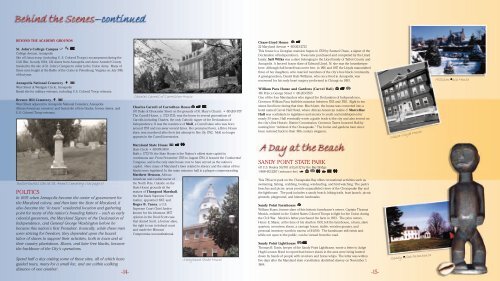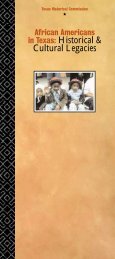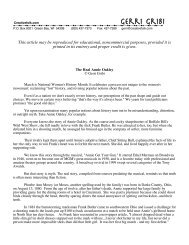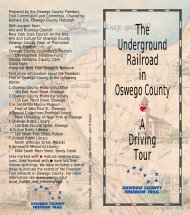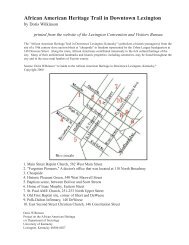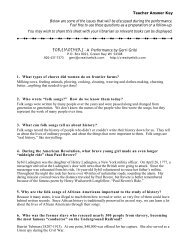Inside this brochure you'll find...
Inside this brochure you'll find...
Inside this brochure you'll find...
You also want an ePaper? Increase the reach of your titles
YUMPU automatically turns print PDFs into web optimized ePapers that Google loves.
BEYOND THE ACADEMY GROUNDS<br />
St. John’s College Campus<br />
College Avenue, Annapolis<br />
Site of Union troop (including U. S. Colored Troops) encampment during the<br />
Civil War. In early 1864, 122 slaves from Annapolis and Anne Arundel County<br />
traveled to the site of St. John’s Campus to enlist in the Union Army. Many of<br />
these men fought at the Battle of the Crater in Petersburg, Virginia on July 30th<br />
of that year.<br />
Annapolis National Cemetery<br />
West Street at Westgate Circle, Annapolis<br />
Burial site for military veterans, including U.S. Colored Troop veterans.<br />
Brewer Hill Cemetery<br />
West Street adjacent to Annapolis National Cemetery, Annapolis<br />
African-American cemetery and burial site of free blacks, former slaves, and<br />
U.S. Colored Troop veterans.<br />
Butler burial site at St. Anne’s Cemetery (see page 3)<br />
POLITICS<br />
In 1695 when Annapolis became the center of government for<br />
the Maryland colony, and then later the State of Maryland, it<br />
also became the “in town” residential location and gathering<br />
point for many of <strong>this</strong> nation’s founding fathers – such as early<br />
colonial governors, the Maryland Signers of the Declaration of<br />
Independence, and General George Washington before he<br />
became <strong>this</strong> nation’s first President. Ironically, while these men<br />
were striving for freedom, they depended upon the bound<br />
labor of slaves to support their activities, both in town and at<br />
their country plantations. Slaves, and later free blacks, became<br />
the backbone of the City’s operations.<br />
Spend half a day visiting some of these sites, all of which have<br />
guided tours, many for a small fee, and are within walking<br />
distance of one another:<br />
-14-<br />
Charles Carroll of Carrollton House<br />
Charles Carroll of Carrollton House<br />
107 Duke of Gloucester Street on the grounds of St. Mary’s Church • 410-269-1737<br />
The Carroll House, c. 1723-1735, was the home to several generations of<br />
Carrolls including Charles, the only Catholic signer of the Declaration of<br />
Independence. It was the residence of Moll, a Carroll slave who was born<br />
around 1753 and ran away several times. Her presumed lover, a Brice House<br />
slave, was murdered after their last attempt to flee. By 1782, Moll no longer<br />
appears in the Carroll inventories.<br />
Maryland State House<br />
State Circle • 410-974-3400<br />
Built c. 1772-79, the State House is the Nation’s oldest state capitol in<br />
continuous use. From November 1783 to August 1784, it housed the Continental<br />
Congress, and is the only state house ever to have served as the nation’s<br />
capitol. Here many of Maryland’s laws related to slavery and the status of free<br />
blacks were legislated. In the main entrance hall is a plaque commemorating<br />
Matthew Henson, African<br />
American and co-discoverer of<br />
the North Pole. Outside on the<br />
State House grounds sit the<br />
statues of Thurgood Marshall,<br />
the first black Supreme Court<br />
Justice, appointed 1967, and<br />
Roger B. Taney, a U.S.<br />
Supreme Court Chief Justice<br />
known for his infamous 1857<br />
opinion in the Dred Scott case<br />
that denied Scott, a former slave,<br />
the right to sue in federal court<br />
and made the Missouri<br />
Compromise unconstitutional.<br />
Maryland State House<br />
Chase-Lloyd House<br />
22 Maryland Avenue • 410-263-2723<br />
This house is a Georgian mansion begun in 1769 by Samuel Chase, a signer of the<br />
Declaration of Independence. It was later purchased and completed by the Lloyd<br />
family. Sall Wilks was a slave belonging to the Lloyd family of Talbot County and<br />
Annapolis. A favored house slave of Edward Lloyd, IV, she was the housekeeper<br />
here. Although Sall herself was never free, in 1816 and 1817 the Lloyds manumitted<br />
three of her daughters, who married members of the city’s free black community.<br />
A great-grandson, Daniel Hale Williams, who once lived in Annapolis, was<br />
renowned for his early heart surgery performed in Chicago in 1893.<br />
William Paca House and Gardens (Carvel Hall)<br />
186 Prince George Street • 410-263-5553<br />
One of the four Marylanders who signed the Declaration of Independence,<br />
Governor William Paca built <strong>this</strong> mansion between 1763 and 1765. Eight to ten<br />
slaves lived here during that time. Much later, the house was converted into a<br />
hotel named Carvel Hall Hotel, where African-American maitre d’ Marcellus<br />
Hall was confidante to legislators and mentor to youth and midshipmen for<br />
nearly 50 years. Hall eventually wrote a guide book to the city and also served on<br />
the city’s first Historic District Commission. Governor Tawes honored Hall by<br />
naming him “Admiral of the Chesapeake.” The home and gardens have since<br />
been restored back to their 18th century elegance.<br />
SANDY POINT STATE PARK<br />
off U.S. Routes 50/301 at Exit 32 by the Bay Bridge<br />
1-888-432-2267 (entrance fee)<br />
This 786-acre park on the Chesapeake Bay offers recreational activities such as<br />
swimming, fishing, crabbing, boating, windsurfing, and bird watching. The park’s<br />
beaches and picnic areas provide unparalleled views of the Chesapeake Bay and<br />
the lighthouse. The park includes a sandy beach, hiking trails, boat launch, picnic<br />
grounds, playground, and historic landmarks.<br />
Sandy Point Farmhouse<br />
William Evans, former slave of <strong>this</strong> historic farmhouse’s owner, Captain Thomas<br />
Mezick, enlisted in the United States Colored Troops to fight for the Union during<br />
the Civil War. Mezick’s father purchased the farm in 1833. The prior owner,<br />
Henry E. Mayer, at the time of his death in 1831, left the farmhouse, a barn, slave<br />
quarters, seventeen slaves, a carriage house, stable, wooden granary, and<br />
personal inventory worth in excess of $4,000. The farmhouse still exists and,<br />
while not open to the public, can be viewed from the road.<br />
Sandy Point Lighthouse<br />
Thomas B. Davis, keeper of the Sandy Point Lighthouse, wrote a letter to Judge<br />
Hugh Lennox Bond to report that former slaves in the area were being hunted<br />
down by bands of people with revolvers and horse whips. The letter was written<br />
five days after the Maryland state constitution abolished slavery on November 1,<br />
1864.<br />
-15-<br />
Chase-Lloyd House<br />
Sandy Point Farmhouse<br />
William Paca House


